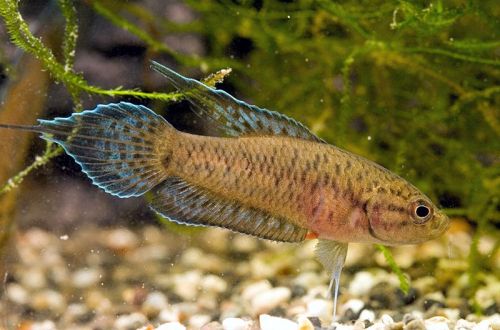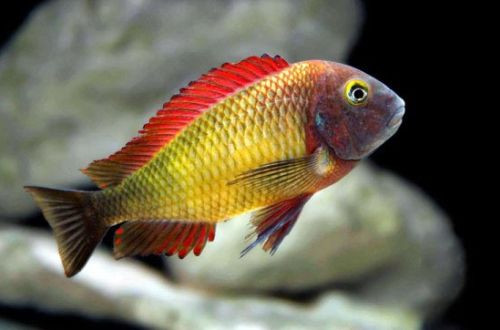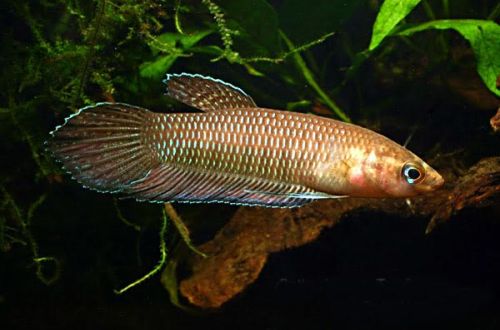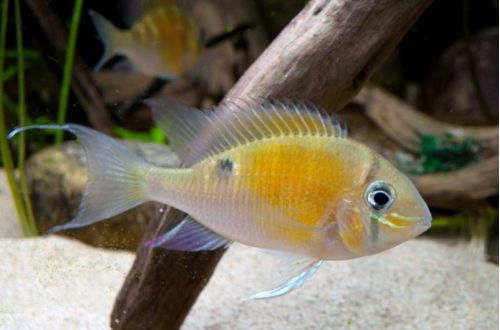
Cresser’s paradise fish
Malpulutta Kretsera or Paradise fish Crestsera, scientific name Malpulutta kretseri, belongs to the Osphronemidae family. Named after the French lawyer and enthusiastic botanist De Kretser, who first discovered and described this species in 1937. Quite easy to keep and breed, compatible with other peaceful fish. Given the fact that this species has practically disappeared in nature, its breeding is of particular importance.

Contents
Habitat
The fish comes from Asia from the island of Sri Lanka, located off the coast of India. In the wild, it was preserved only in the southwestern part of the island in the tropical rainforest zone, from which no more than 2000% of the original area remained by the mid-4s. This area receives a large amount of precipitation, annually about 2000–3000 mm. There are no pronounced dry periods. The air temperature is stable and stays at around 25 to 27 °C. The typical habitat is small undisturbed streams flowing through the jungle. Sunlight practically does not penetrate through the dense crown of trees, so the litter remains twilight even during the day, and the water does not warm up, remaining cool. Aquatic vegetation is rare, mainly represented by coastal plants. The sandy bottom is covered with a layer of fallen leaves, branches, and numerous tree roots pass through the channel.
Brief information:
- The volume of the aquarium – from 40 liters.
- Temperature – 16-22°C
- Value pH — 5.0–7.5
- Water hardness – 1–9 dGH
- Substrate type – any
- Lighting – subdued
- Brackish water – no
- Water movement – little or no
- The size of the fish is 4–5 cm.
- Food – any food
- Temperament – peaceful
- Content – paired or in a group.
Description
Adults reach a length of 3–5 cm. Males are somewhat larger and brighter, and their fins have elongated extreme rays at the anal and unpaired fins. The coloration is gray-yellow with dark speckles all over the body. The fins have bluish tints and the same edging.
Food
An omnivorous species, it will accept most popular commercial flake and pellet foods, as well as specialized frozen foods. If desired, you can use live food, such as bloodworms, daphnia, brine shrimp, fruit flies and other small insects.
Maintenance and care, arrangement of the aquarium
The optimal size of the aquarium for a pair of fish starts from 40 liters. Most of the specimens presented for sale have been living in an artificial environment for many generations. During this time, they managed to adapt to slightly different conditions than those in which their wild relatives live. The design is arbitrary, provided that there are places for shelters and a subdued level of lighting is set, or floating plants are used for shading. The addition of the leaves of some trees will make it possible to give the water a composition characteristic of natural reservoirs, due to the release of tannins in the process of decomposition.
When keeping Malpulutta Crestsera, it is important to create and maintain a stable aquatic environment within acceptable temperature ranges and hydrochemical values. For this, the necessary equipment is installed and a number of mandatory aquarium maintenance procedures are carried out: organic waste is removed, part of the water is replaced with fresh water with the same pH and dGH values, and so on.
Behavior and Compatibility
Basically peaceful fish, although some individuals may not be too friendly to relatives. First of all, this applies to males. In a small aquarium, pair keeping is recommended. Compatible with other non-aggressive fish of similar size.
Breeding / breeding
In favorable conditions, spawning occurs regularly. With the onset of the breeding season, males begin to build a foam-air nest among thickets of plants. In their absence, snags or other decorative elements can be selected. After construction is completed, courtship begins. Spawning itself is accompanied by a kind of embrace dance, during which the fish tightly wrap themselves around each other. At this point, the eggs are fertilized. All eggs are immediately transferred to the nest. The males stay close to the clutch to guard it until the fry begin to swim on their own – this takes about a week. If breeding is carried out in a common aquarium, then the juveniles should be transplanted into a separate tank in order to avoid predation by other fish.
Fish diseases
The cause of most diseases is unsuitable conditions of detention. A stable habitat will be the key to successful keeping. In the event of symptoms of the disease, first of all, the quality of the water should be checked and, if deviations are found, measures should be taken to correct the situation. If symptoms persist or even worsen, medical treatment will be required. Read more about symptoms and treatments in the Aquarium Fish Diseases section.





